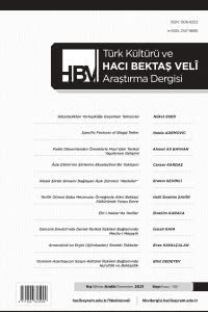HABİBZÂDE RODOSLU AHMET KEMAL’İN (1889-1966) CEM SULTAN HAKKINDA BİLİNMEYEN BİR TİYATRO ESERİ
Bu çalışmada soyadı kanunun kabul edilmesinden sonra “Ahmet Kemal İlkul” olarak anılmaya başlanan, “edebiyatçı” kimliğinden çok özellikle İttihat ve Terakki Cemiyeti içerisindeki faaliyetleriyle ön plana çıkan Habibzâde Rodoslu Ahmet Kemal’in (1889-1966) “Sultan Cem Yâhud Tâli‘siz Şehzâde” adlı tiyatro eseri üzerinde durulacaktır. Habibzâde Rodoslu Ahmet Kemal, II. Meşrutiyet’in ilanından sonra Rodos’tan İstanbul’a yerleşmiş, İstanbul’da öğretmenlik yaptığı sırada fikirlerine henüz Rodos’ta iken aşina olduğu ve yakınlık duyduğu İttihat ve Terakki Cemiyeti mensuplarıyla bir araya gelmiştir. İttihat ve Terakki Cemiyeti’nin eğitim öğretim kurumlarında, yayın organlarında görev yapan Habibzâde Rodoslu Ahmet Kemal, bizzat Talat Paşa ve Ziya Gökalp tarafından Doğu Türkistan’daki Türkler arasında eğitim-öğretim faaliyetlerini yürütmek ve Türklük bilincinin oluşmasına ve gelişmesine katkı sağlamak üzere görevlendirilmiştir. Yazarın şimdiye kadar bilinen dokuz eseri bulunmaktadır. “Sultan Cem Yâhud Tâli‘siz Şehzâde” adlı eseri ise edebiyat tarihlerinde yer almamaktadır. Bu eser, 1328 (1910/1911) yılında kaleme alınmış olup 40 yapraktır. Eser, basılmamış olup, tek yazma nüshası Milli Kütüphane Yazmalar Koleksiyonu 06 Mil Yz. A. 8676 numarada kayıtlıdır. Eser, Sultan Cem’in, babası Fatih Sultan Mehmet’in ölümünden sonra tahta geçen ağabeyi II. Bayezid ile giriştiği taht mücadelesine ve bu yolda çektiği “sıkıntı”lara odaklanmaktadır. Bu çalışmada öncelikle Habibzâde Rodoslu Ahmet Kemal ve eserlerinden söz edilecek, daha sonra da “Sultan Cem Yâhud Tâli‘siz Şehzâde” adlı eserinin incelemesi yapılacaktır. Çalışmanın sonunda eserin çeviri yazımına yer verilecektir. Böylelikle hem Habibzâde Rodoslu Ahmet Kemal’in edebiyatçı kimliğini vurgulamak hem de edebiyat tarihlerindeki bir boşluğu doldurmak amaçlanmaktadır.
AN UNKNOWN THEATER WORK ABOUT SULTAN CEM BY HABİBZÂDE RODOSLU AHMET KEMAL (1889-1966
This study aims to investigate the theater work titled “Sultan Cem or the Unlucky Prince” by Habibzâde Rodoslu Ahmet Kemal (1889-1966), who stood out with his activities at the Committee for Union and Progress rather than his literary identity, and who started to be called as “Ahmet Kemal İlkul” after the acceptance of the surname law. Habibzâde Rodoslu Ahmet Kemal moved from the island of Rhodes to Istanbul after the announcement of the Second Constitutional Monarchy. He came together with the members of the Committee for Union and Progress, the ideas of which he was familiar and of which he felt closeness while he was still on the island of Rhodes during the period when he was a teacher in Istanbul. Habibzâde Rodoslu Ahmet Kemal worked in the educational institutions and publication organs of the Committee for Union and Progress and he was personally given the duty to carry out the educational activities among the Turks in Eastern Turkistan and to provide contributions to the formation and development of the awareness of being Turkish by Talat Pasha and Ziya Gökalp. Heretofore, there are nine works of the author that are known and have been found. Whereas, the work titled “Sultan Cem or the Unlucky Prince” is not included in the records of literature. This work was written in 1328 (1910/1911) and has 40 leaves. The work was not printed, and the only handwritten manuscript copy is registered at 06 Mil Yz. A. No. 8676 of the Handwritten Manuscript Collection at the National Library. The work focuses on Cem Sultan’ struggles for the throne with his older brother Bayezid II, who ascended the throne after the death of their father Sultan Mehmet the Conqueror and the “difficulties” he suffered on this course. First, in the present study, Habibzâde Rodoslu Ahmet Kemal and his works are mentioned and then later a careful examination of the work titled “Sultan Cem or the Unlucky Prince” will be carried out. At the end of the study, the work will be converted into the Latin alphabet. In this manner, it is aimed both to emphasize the literary identity of Habibzâde Rodoslu Ahmet Kemal and to fill a gap in the literature history
___
- Abdurrahman (Çakan) Vâris. (2001). “Doğu Türkistan’daki ‘Ceditçilik’ Hareketi ve Ahmet Kemal
İlkul”. Türk Yurdu 170, 51-58.
- Adil Hikmet Bey (1998). Asyada Beş Türk. Haz. Yusuf Gedikli. İstanbul: Ötüken Yayınları.
- And, Metin (2017). Başlangıcından 1983’e Türk Tiyatro Tarihi. İstanbul: İletişim Yayınları.
- Erkul Yağcı, Ahu Selin. (2012). “Turkey’s Reading (R)evolution: A Study on Books, Readers
and Translation (1840- 1940)”. Yayımlanmamış Doktora Tezi. İstanbul: Boğaziçi
Üniversitesi.
- Ersoy, Ayşe Fersahoğlu. (2010). “Habibzâde Ahmet Kemal’in Kahramanlık Temalı Ninni Şiirleri”.
A.Ü. Türkiyat Araştırmaları Enstitüsü Dergisi 44, 157-181.
- İlkul, Ahmet Kemal (Habibzade Rodoslu Ahmet Kemal). (1328). “Sultan Cem Yahud Tâli’siz
Şehzâde”.
- İlkul, Ahmet Kemal. (1333). Elifbâ-yı Türkî. Orenburg: Vakit Matbaası. https://archive.org/details/HabibzadeAlifbaYiTurki
- İlkul, Ahmet Kemal. (1962). Bir Yetimin Hayâtı. İstanbul: Hamle Matbaası.
- İlkul, Ahmet Kemal. (1996). Çin Türkistan Hatıraları Şanghay Hatıraları. Haz. Yusuf Gedikli. İstanbul: Ötüken
Yayınları.
- Sarıbal, İsmet. (2018). “Fatihli Mehmed Tevfik Paşa’nın Şehzâde Cem Kitabı” Tarih Okulu
Dergisi (TOD). Yıl 11, Sayı XXXIV, s. 197-232.
- Uzunçarşılı, İsmail Hakkı. (2011). Osmanlı Tarihi II. Cilt (İstanbul’un Fethinden Kanuni Sultan
Süleyman’ın Ölümüne Kadar) Ankara: Türk Tarih Kurumu Yayınları.
